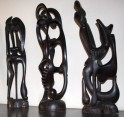Makonde styles of carving
The world's most famous works of art of the Makonde are probably their Christian motives which they began to carve since the missionary in East Africa. The abbey Münsterschwarzach was (still is?) quite active in importing this art to Germany. Madonnas, crucifixes, nativity figures but also carved chess figures and portraits are found in Europe today and beautiful pieces can even be bought on the Internet from time to time.
In my opinion, however, the three mainly modern styles of Makonde are far more interesting:
Shetani (demon, spirit, devil)
Mawingu (cloud)
Ujamaa (community, family)
These sculptures were developed in the later 20th Century and are characterized by the influence of mostly European buyers. Terefore I would say that these sculptures are not really a traditional form of art, but rather of a very modern and refreshing facet of African Art. Almost all of Makonde carvings, however, have one thing in common - they are made of Ebony, and almost always carved in a perfect manner.
For me the most fascinating sculptures of the Makonde are the so called Shetani. Every piece is completely unique, they are almost always representing mythical creatures from the Makonde mythology. As widespread in African culture, the Makonde carver feels constantly surrounded and observed by these creatures.
So he is carving his fantasies and dreams and is thereby also guided by the growth habit of often bizarre ebony wood. The carved scenes are very dynamic and powerful, and usually show several intertwined bodies. Shetani sculptures often contain reptiles (chameleon and snakes), amphibians, fishes and birds that bite each other, swallow and climb the central figure of the carving. Almost always, the feet of one or more pieces are inspired by the hoof of a goat.
The importance of senses is illustrated in the Shetani by abstraction of eyes, teeth and ears. A large, soft eye means, according to the carvers, rather a good spirit.






The Swahili word Mawingu means cloud. The correlation can be seen in most of these beautiful figures held in massive, soft, intricate shapes. Between Shetani and Mawingu I think the border is a bit flowing. The Mawingu sculptures are more ore less charming, not aggressive and much more abstract than the Shetani are. But often a Mawingu figure also has a face and possibly legs so that the beholder can recognize a body. These sculptures leave much space for his imagination. They remind me somehow of figures by Henry Moore.





The Ujamaa style, formerly called Dimingo, developed around 1960 and was significantly influenced by the socialist policies in the country. Ujamaa which means community and family, is obviously seen in these carvings in a very beautiful way. They are often described as tree of life or family. Shown is almost always a more central figure (tribal chief) arround whom smaller figures (family or tribal members) are arranged. These are frequently shown while performing traditional local work, eg farming, herding or shown during cooking.
Really good Ujamaa pieces are carved properly clean and fragile from a large, preferably branched, tree trunk - there are also specimens that are several meters high!





Names of the mos known carvers can be found on this page: Artists